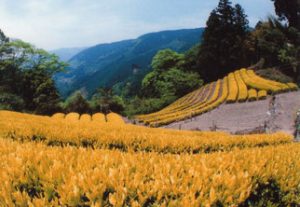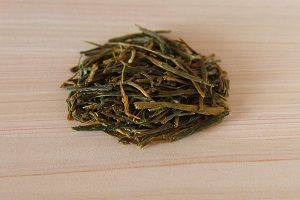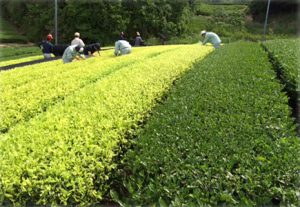
Because of my previous tea review, I became interested in Hakuyoucha (白葉茶, white leaf tea).
We’re not talking about a white tea here, it’s an uncommon green tea made with leaves that have a color ranging from very pale green to yellow.
There are two types of white leaf tea:
White leaf tea cultivars

Some cultivars have “white” leaves, although this only happens on the first flush. After that, the leaves become green as usual.
The cultivars started as natural mutations, and the tea farmers started to grow them by cuttings.
This process takes years. Having a tea field big enough for harvesting, while starting from a single white leaf tea plant is quite a feat.
Naturally, production of white leaf tea cultivars is low and the price is high.
As far as I know, these are the Japanese white leaf tea cultivars:
Kiraka (きら香) Found in Fukuroi city, Shizuoka prefecture. Tea farmer: Mr. Takeuchi.
Hoshinomidori (星野緑, Hoshino green) Fukuoka prefecture. Tea farmer: Mr. Inoue.
Koganemidori (黄金みどり, green gold) Morokozawa, a part of Shizuoka city, Shizuoka prefecture. Tea farmer: Mr. Sato.
Yamabuki (山吹) Named after the Japanese kerria, a yellow flower. Found in Shimizu ward of Shizuoka city, Shizuoka prefecture. Tea farmer: Mr. Sugiyama.
Artificial white leaf tea

Actually, there’s a cultivation technique that lets you obtain white leaf tea from any cultivar!
I don’t know exactly how it works, but it involves heavy shading (close to 100%) of the tea leaves for two to three weeks.
Some cultivars lend themselves better for this process than others.
From what I’ve seen, not that many people make artificial white tea. Perhaps the demand isn’t that high yet?
More about white leaf tea
This tea is rich in amino acids, twice as much as a sencha from the Yabukita cultivar. The catechin content is often lower, however.
I’ve only tried one white leaf tea, but from what I’ve read they all have a high umami flavor, good sweetness, and low astringency and bitterness.
The liquor ranges from clear, pale green to a golden color.
I hope one day this tea becomes more available, because I really liked it.
You can purchase it online if you look for it, some online stores sell it outside Japan.
The price is high, but probably worth it for most green tea lovers.





January 19, 2016
Very interesting Ricardo! I’ve never heard of this before. Hope I can try some one day!
January 19, 2016
Hi Rona
Thank you for the comment. Yes, few people have heard of it because its production is very limited.
Even I only heard about it recently.
January 23, 2016
I had no idea there were other “white leaf” cultivars and cultivators out there besides Kiraka. Nor did I know that Kiraka is the result of one farmer’s attempts.
I’ve only had one as well, but it was as you described.
January 23, 2016
Hi Geoff, thanks for your comment.
The Kiraka tea was very good. We still have a lot of rare teas to try!
February 4, 2016
Interesting! Hope I can try this one day.
February 4, 2016
Hi Burt
Every passing day it’s becoming easier to obtain even the most obscure teas. You are in luck!